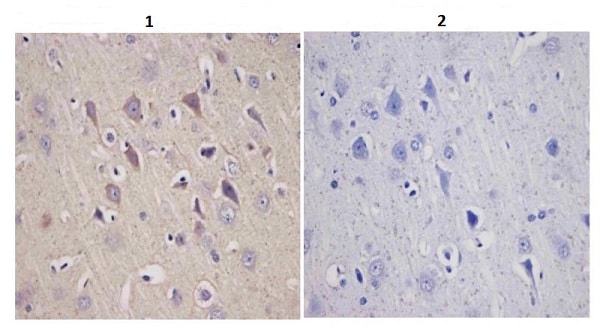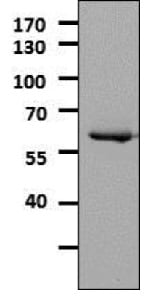Anti-Tyrosine Hydroxylase 抗体 - Neuronal Marker (ab112)
Key features and details
- Rabbit polyclonal to Tyrosine Hydroxylase - Neuronal Marker
- Suitable for: IHC-P, WB
- Reacts with: Rat
- Isotype: IgG
リコンビナント抗体で、ロット間での高い再現性を実現
- 異なるロット間での安定した再現性
- 容易なスケールアップ
- 評価試験による特異性の確認済み
- 倫理基準に準拠 - アニマル・フリーの生産
製品の概要
-
製品名
Anti-Tyrosine Hydroxylase antibody - Neuronal Marker
Tyrosine Hydroxylase 一次抗体 製品一覧 -
製品の詳細
Rabbit polyclonal to Tyrosine Hydroxylase - Neuronal Marker -
由来種
Rabbit -
アプリケーション
適用あり: IHC-P, WBmore details -
種交差性
交差種: Rat
交差が予測される動物種: Mammals
-
免疫原
Full length native protein (purified) corresponding to Rat Tyrosine Hydroxylase aa 1 to the C-terminus. Full length SDS denatured protein purified from rat pheochromocytoma.
Database link: P04177 -
ポジティブ・コントロール
- WB: PC-12 whole cell lysate. Rat caudate and striatal lysate. IHC-P: Rat brain tissue.
-
特記事項
ab112 can be used as a marker for dopaminergic and noradrenergic neurons.
The Life Science industry has been in the grips of a reproducibility crisis for a number of years. Abcam is leading the way in addressing this with our range of recombinant monoclonal antibodies and knockout edited cell lines for gold-standard validation. Please check that this product meets your needs before purchasing.
If you have any questions, special requirements or concerns, please send us an inquiry and/or contact our Support team ahead of purchase. Recommended alternatives for this product can be found below, along with publications, customer reviews and Q&As
製品の特性
-
製品の状態
Liquid -
保存方法
Shipped at 4°C. Store at +4°C short term (1-2 weeks). Upon delivery aliquot. Store at -20°C long term. Avoid freeze / thaw cycle. -
バッファー
pH: 7.50
Constituents: 0.01% BSA, 0.87% Sodium chloride, 50% Glycerol, 0.238% HEPES -
 Concentration information loading...
Concentration information loading... -
精製度
Protein A purified -
ポリ/モノ
ポリクローナル -
アイソタイプ
IgG -
研究分野
関連製品
-
Compatible Secondaries
-
Isotype control
-
Positive Controls
-
Recombinant Protein
-
Related Products
アプリケーション
The Abpromise guarantee
Abpromise保証は、 次のテスト済みアプリケーションにおけるab112の使用に適用されます
アプリケーションノートには、推奨の開始希釈率がありますが、適切な希釈率につきましてはご検討ください。
| アプリケーション | Abreviews | 特記事項 |
|---|---|---|
| IHC-P | (16) |
1/750.
|
| WB | (4) |
1/200. Predicted molecular weight: 60 kDa.
|
| 特記事項 |
|---|
|
IHC-P
1/750. |
|
WB
1/200. Predicted molecular weight: 60 kDa. |
ターゲット情報
-
機能
Plays an important role in the physiology of adrenergic neurons. -
組織特異性
Mainly expressed in the brain and adrenal glands. -
パスウェイ
Catecholamine biosynthesis; dopamine biosynthesis; dopamine from L-tyrosine: step 1/2. -
関連疾患
Defects in TH are the cause of dystonia DOPA-responsive autosomal recessive (ARDRD) [MIM:605407]; also known as autosomal recessive Segawa syndrome. ARDRD is a form of DOPA-responsive dystonia presenting in infancy or early childhood. Dystonia is defined by the presence of sustained involuntary muscle contractions, often leading to abnormal postures. Some cases of ARDRD present with parkinsonian symptoms in infancy. Unlike all other forms of dystonia, it is an eminently treatable condition, due to a favorable response to L-DOPA.
Note=May play a role in the pathogenesis of Parkinson disease (PD). A genome-wide copy number variation analysis has identified a 34 kilobase deletion over the TH gene in a PD patient but not in any controls. -
配列類似性
Belongs to the biopterin-dependent aromatic amino acid hydroxylase family. - Information by UniProt
-
参照データベース
- Entrez Gene: 25085 Rat
- SwissProt: P04177 Rat
- Unigene: 11082 Rat
-
別名
- Dystonia 14 antibody
- DYT14 antibody
- DYT5b antibody
see all
画像
-
Anti-Tyrosine Hydroxylase antibody - Neuronal Marker (ab112) at 1/200 dilution + PC-12 (Rat adrenal gland pheochromocytoma cell line) whole cell lysate
Predicted band size: 60 kDa -
 Immunohistochemistry (Formalin/PFA-fixed paraffin-embedded sections) - Anti-Tyrosine Hydroxylase antibody - Neuronal Marker (ab112)
Immunohistochemistry (Formalin/PFA-fixed paraffin-embedded sections) - Anti-Tyrosine Hydroxylase antibody - Neuronal Marker (ab112)Paraffin embedded sections of rat brain tissue were stained for Tyrosine Hydroxylase with ab112 at 1/5000 dilution in immunohistochemical analysis (Panel 1).
Panel 2 shows an image in which ab112 was replaced with a Rabbit IgG1 isotype control.
-
 Immunohistochemistry (Formalin/PFA-fixed paraffin-embedded sections) - Anti-Tyrosine Hydroxylase antibody - Neuronal Marker (ab112)This image is courtesy of an Abreview submitted by Dr Guillermo Estivill-Torrus
Immunohistochemistry (Formalin/PFA-fixed paraffin-embedded sections) - Anti-Tyrosine Hydroxylase antibody - Neuronal Marker (ab112)This image is courtesy of an Abreview submitted by Dr Guillermo Estivill-Torrusab112 at 1/500 staining rat brain tissue (ab29475) sections by IHC-P.
The tissue was paraformaldehyde fixed and blocked with serum prior to incubation with the antibody for 14 hours. A biotinylated swine anti-rabbit IgG was used as the secondary.
-
 Immunohistochemistry (Formalin/PFA-fixed paraffin-embedded sections) - Anti-Tyrosine Hydroxylase antibody - Neuronal Marker (ab112)This image is courtesy of an anonymous Abreview
Immunohistochemistry (Formalin/PFA-fixed paraffin-embedded sections) - Anti-Tyrosine Hydroxylase antibody - Neuronal Marker (ab112)This image is courtesy of an anonymous Abreviewab112 at 1/800 staining rat dopaminergic neuronal tissue sections (araldite resin sections) by immunohistochemistry.
The tissue was paraformaldehyde fixed and then an antigen retrieval step was carried out (heat mediated). A biotinylated goat anti-rabbit IgG (ab6720) was used as the secondary.
-
Anti-Tyrosine Hydroxylase antibody - Neuronal Marker (ab112) at 1/200 dilution + rat caudate lysate at 10 µg
Predicted band size: 60 kDa -
Anti-Tyrosine Hydroxylase antibody - Neuronal Marker (ab112) at 1/200 dilution + rat striatal lysate at 10 µg
Predicted band size: 60 kDa
プロトコール
データシートおよび資料
-
SDS download
-
Datasheet download
参考文献 (332)
ab112 は 332 報の論文で使用されています。
- Dong AQ et al. Pramipexole inhibits astrocytic NLRP3 inflammasome activation via Drd3-dependent autophagy in a mouse model of Parkinson's disease. Acta Pharmacol Sin 44:32-43 (2023). PubMed: 35896696
- Ramírez-Plascencia OD et al. Leptin and adiponectin regulate the activity of nuclei involved in sleep-wake cycle in male rats. Front Neurosci 16:907508 (2022). PubMed: 35937866
- Bayley JP et al. Long-term in vitro 2D-culture of SDHB and SDHD-related human paragangliomas and pheochromocytomas. PLoS One 17:e0274478 (2022). PubMed: 36178902
- Mazumder S et al. Post-mortem brain histological examination in the substantia nigra and subthalamic nucleus in Parkinson's disease following deep brain stimulation. Front Neurosci 16:948523 (2022). PubMed: 36188463
- Xu J et al. Therapeutic function of a novel rat induced pluripotent stem cell line in a 6‑OHDA‑induced rat model of Parkinson's disease. Int J Mol Med 50:N/A (2022). PubMed: 36300203








